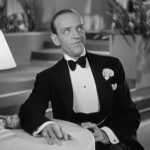 |
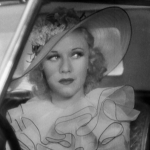 |
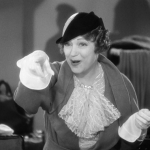 |
| Guy Holden … Fred Astaire |
Mimi Glossop … Ginger Rogers |
Aunt Hortense … Alice Brady |
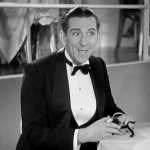 |
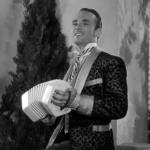 |
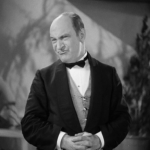 |
| Egbert Fitzgerald … Edward Everett Horton |
Rodolfo Tonetti … Erik Rhodes |
The Waiter … Eric Blore |
Proof That It’s Pre-Code-ish
- The title of the Broadway show this is based on was called The Gay Divorce, but the censors were worried that it would indicate that the process of divorce could be a happy, jubilant one. Instead it was mandated that the movie become The Gay Divorcee, indicating that getting a divorce may not be fun, but you could sure have a lot of fun doing it.
- Some quotes:
“Marriage is a weakness of men that women take advantage of.”
“A man tore my dress off!”
“Anyone we know?”
“Remind me to come down here next time I want my constitution compromised.”
“You can’t have a clandestine affair between three people!”
“That’s what you say!”
“I’ve never tried breakfast with two gentleman before!”
The Gay Divorcee: I Need a Cigarette
“Be feminine and sweet. If you can blend the two.”
Fred Astaire and Ginger Rogers, the famous dancing team, may have gotten their start in Flying Down to Rio but The Gay Divorcee is their first solo starring effort, and readily establishes the formula for most of the rest: two charming people overcome obstacles in a slight farce until a big song and dance number allows them to waltz into the sunset. An array of eccentrics lurk in the background with catty comments and charm to spare.
Oddly, even with Astaire and Rogers in the lead, my complaints about Flying Down to Rio are valid here as well. The main romance plot is contrived and silly, and the amusing side characters pretty much run off with the piece uninhibited.
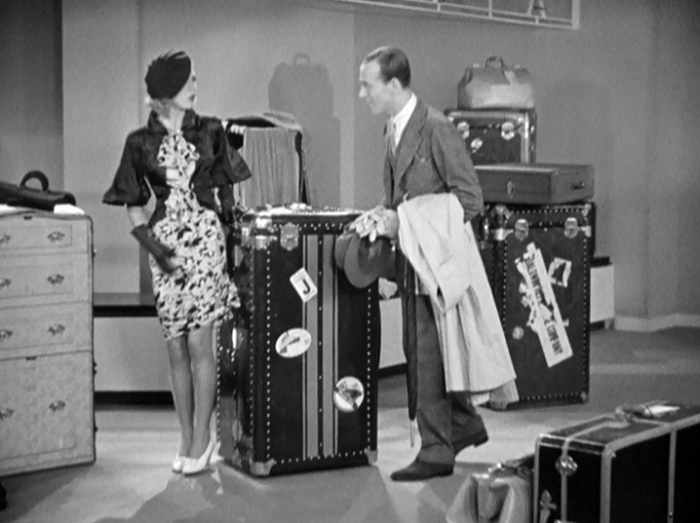
“Pardon me, m’am, have you been leered at lately?”
First, the plot. The movie is a total lark, so I’ll save you too much detail: Mimi is in London seeking a divorce, where Guy, a dancer, meets her over a skirt trapped in a traveling trunk. He’s smitten, so through car chases and swing dancing he tracks her down to a hotel resort where his lawyer pal, Egbert, has arranged for her to have a fake love affair uncovered to provoke her husband to leave her. A few songs, a little dance, everything turns out okay.
Gay Divorcee came out about three months after the Code became enforced in 1934, and you can tell. While there are still a few naughty double entendres that slip through, a lot of the spice has been toned down– the sexiness has become merely flirtation in all but a few instances, and the movie seems to curdle at the thought of romance outside of a few dance numbers.
Most problematic is Rogers’ Mimi, who is mostly unpleasant. She seems constantly in a bad mood, which makes sense for a character seeking a divorce, not so much for someone in a light musical comedy in which she is literally sold as a gay divorcee. The vivaciousness of Rogers’ other pre-Code characters is gone, leaving a woman who seems to lack free will and must be effortlessly won and seduced. She does no seduction on her own, following Astaire’s lead at every turn, and not just when they’re dancing. Mimi, like a lot of other women in the Code era, lacks a great deal of verve.
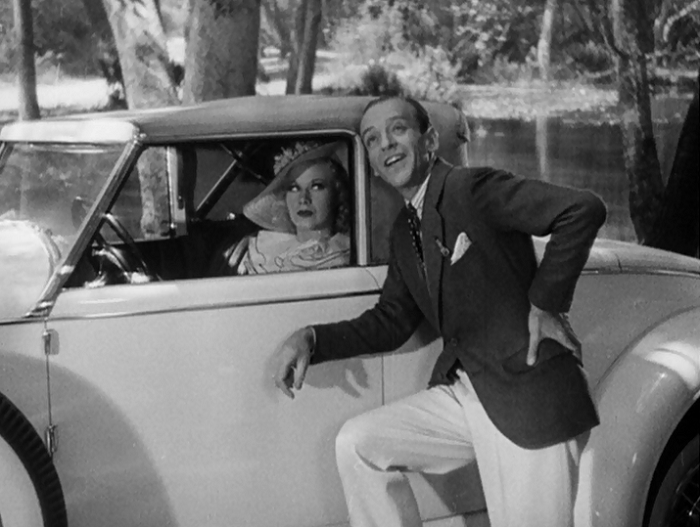
“Hrm, time to be stalked again.”
Astaire’s Guy isn’t actually a whole lot better. Because Mimi can’t be shown to be complicit in her own seduction due to her marriage, Guy has to do double the work, chasing after Mimi in a way that people may closely associate with the life and hobbies of Mark David Chapman.
The secondary cast is more charming and fun, thankfully, with Edward Everett Horton turning in his usual daffy performance and Alice Brady managing a fair bit of silliness as a scatterbrained aunt. Their relationship lacks any spark as well, though that’s a bit more forgivable since their eventually nuptials essentially serve as an inexplicable punchline.
The film’s numbers are probably the most important part, even if they’re rare and pretty hit or miss. Astaire’s solo dances, while impressive as feats of physical control, push the film to a complete stop. There are many sources that note that the film’s climactic dance number of “The Continental” clocks in at 17 minutes, and I presume that’s so you can do some quick math when you check to see how much longer you’ve got to go. It’s an attempt to redo the success of Flying‘s “Carioca”, though I couldn’t tell you how to do a single move of “The Continental” even after 17 minutes of repeated instruction.
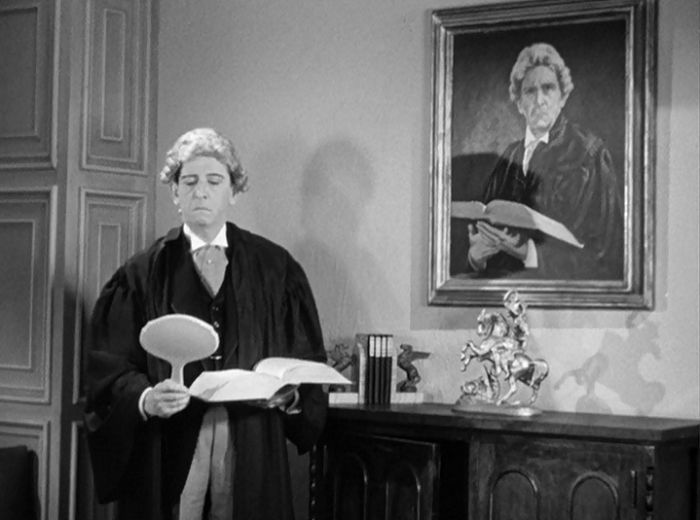
I do this in my spare time, too.
The film’s two best numbers, though, are absolutely brilliant pieces. “Night and Day”, a long dual dance between Astaire and Rogers is erotic in its soft pedaled tempo. Rogers ends the dance sitting next to a thick white column, her back arched, her toes up, and Astaire casually offers her a cigarette. The film treats this dance coyly, as well, hiding behind the windows like a curious child gazing on to something ethereal and mysterious. It’s a shame that this happens at the halfway point; it’s better than the cinematic consummation in most other movies.
The other highlight is Horton’s duet with a very young Betty Grable in “Knockin’ Knees” (whose lyrics are about as suggestive as you’ll get at this point). It’s the most fun number, and Horton, who can’t sing a lick, manages to sell his character’s general daftness as he works out exactly what ‘knee knocking’ entails. For all of the grace and charm the rest of the film exudes, this is probably the only part that manages to escape the hoary conventions and become unabashedly fun.
The Gay Divorcee is pretty light fare that drags too often for my taste. It’s worth checking out for the expensive and expansive art deco design and the smoothness emanating from everyone involved. However, because the movie is a leaden 100 minutes long, your socks will remain firmly on for the duration of the picture.
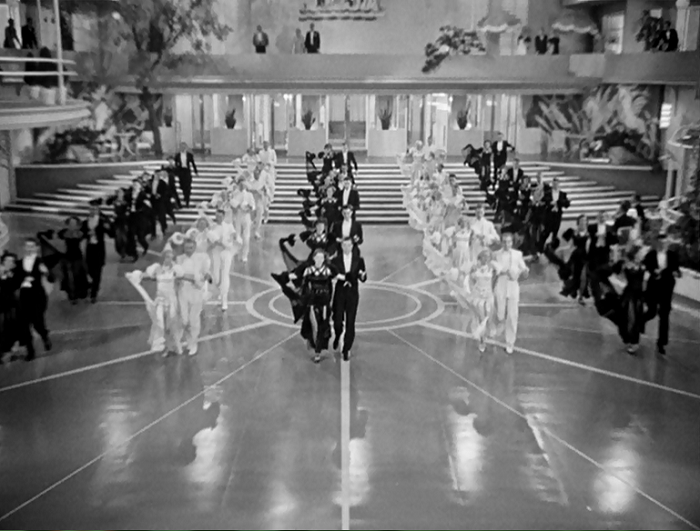
Still going.
Trivia & Links
- The second team up of Fred Astaire and Ginger Rogers after Flying Down to Rio. Flying and Divorcee are the only two pre-Code (or close to pre-Code) entries in the film series, but I’ve seen all of them and my favorites of these are Carefree and Shall We Dance. Check them out if you get a chance.
- Andre Sennwald for the New York Times is delighted by this film, noting:
“Both as a romantic comedian and as a lyric dancer, Mr. Astaire is an urbane delight, and Miss. Rogers keeps pace with him even in his rhythmic flights over the furniture. The audience meets Mr. Astaire and “The Gay Divorcee” at their best when he is adjusting his cravat to an elaborate dance routine or saying the delicious things with his flashing feet that a librettist would have difficulty putting into words.”
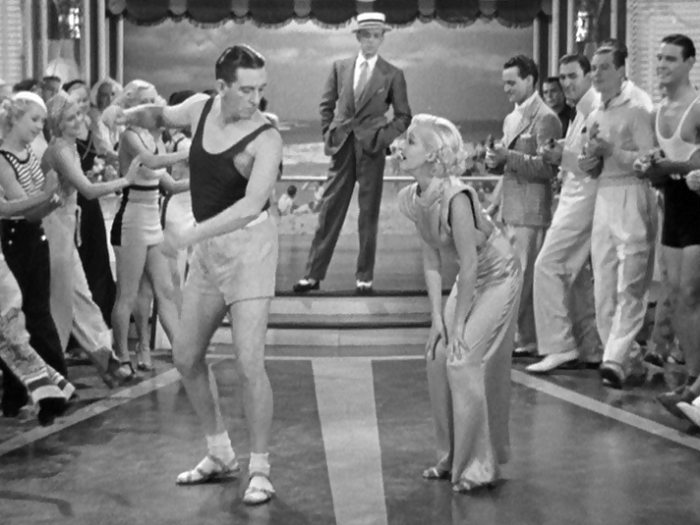
It’s interesting that in this film’s world that musical numbers just kind of happen, and people can wander into them and be baffled, like Fred here.
- The DVD Savant hits a bunch of the Astaire and Rogers pictures to review, and describes why the pair works so well on the screen:
“Astaire and Rogers are cute, funny and thoroughly sentimental under their sophisticated jokes about divorce. They wear evening clothes that verge on Utopian fantasy. They’re so obviously made for each other that we’re behind them all the way. Their dancing skills represent a shared ability to fly, and they’re birds of a feather.”
- Film Fanatic.Org has some more screenshots and a nice review.
- Reel Classics has everything you could ever want about the film, from lyrics to songs.
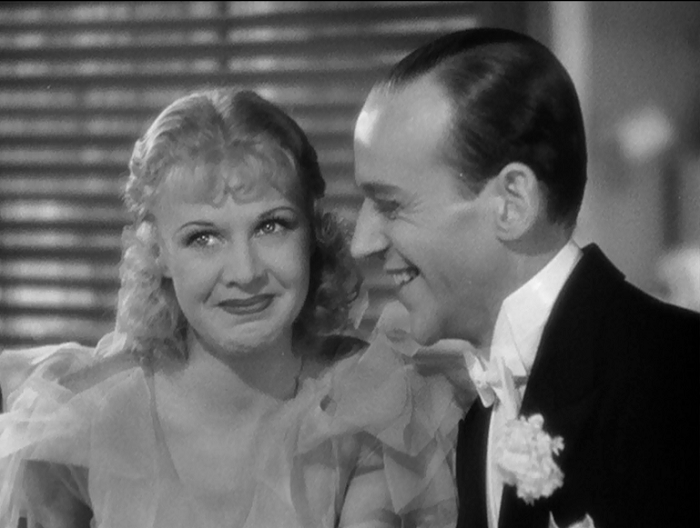
ASTAIRE AND ROGERS WILL RETURN IN OCTOPUSSY. Er, or Roberta.
- Classicfilmboy adores this film. He discusses what it was about Astaire’s dancing that makes the film seems so exciting and new:
“Outside of the short dance Astaire does in the Paris nightclub, the next number is a magnetic solo, “A Needle in a Haystack.” Here Guy is preparing to find Mimi and dances as he gets ready. He’s up on a chair or catching his hat and umbrella from his valet, and the number ends with him heading out the door. It moves the plot along while being exuberant, creative and full of life. Astaire was probably unlike anyone on film before, and he carries this standard through nearly every solo he put on film throughout his career.
Also, think of this: This number was without a partner, chorus girls, a chorus line or anything else that you might expect from a dance sequence. For an untried movie star, this was revelatory.“
- TCM points out that this movie did start a trend, even if it wasn’t people boogeying to “The Continental”:
“A publicity stunt for The Gay Divorcee in which RKO organized “Continental” demonstrations and parties never really helped the dance catch on, but one thing in that extravagant number did start a fad. Reportedly, sales of Venetian blinds soared after audiences got a taste of the window treatments in Van Nest Polglase and Carroll Clark’s inventive set design.”
Gallery
Hover over for controls.
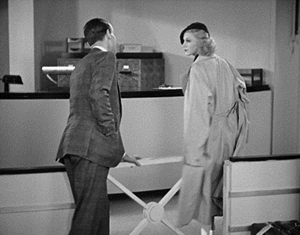
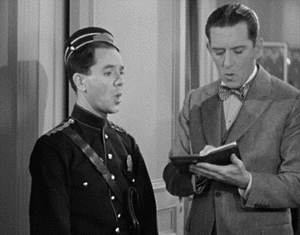
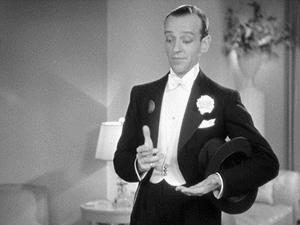
Awards, Accolades & Availability
- This film appeared in the Wikipedia List of Pre-Code Films.
- This film is available on Amazon on DVD individually, to stream, or in their Greatest Classic Film Collection. It can also be rented from Classicflix.
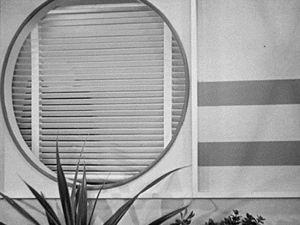 |
Comment below or join our email subscription list on the sidebar!Home | All of Our Reviews | What is Pre-Code? |
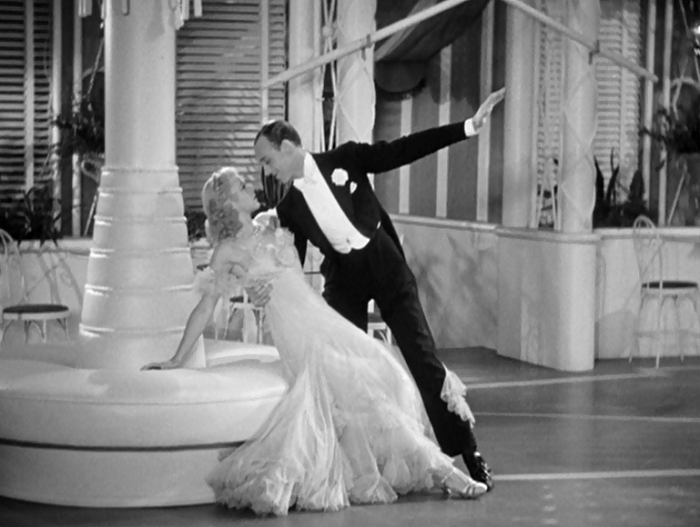




9 Comments
Rick · December 20, 2013 at 3:56 pm
Danny, it has its flaws, but remains one of my favorite Astaire-Rogers films. I like the lead characters better than you, but agree that the supporting ones steal the film. Erik Rhodes’ correspondent is a delight and Ive always found Blore to be wryly amusing.
Danny · December 20, 2013 at 4:22 pm
Yeah, the supporting cast really saves it for me. I don’t dislike it by any means, but I can see the grasping talons of censorship swooping in, and it really dilutes the experience for me. I think if it were made six months earlier, maybe something could have come from The Continental other than an unending dance sequence and maybe Rogers could have had more of a say in her own pursuit. As it is, I wouldn’t avoid it again, but I didn’t enjoy it as much as the unhinged Flying Down to Rio.
silverscreenings · December 21, 2013 at 6:32 am
I like what you said about the supporting characters running away with the film. So true!
Like you, I find Ginger Rogers rather unlikeable, but I love the overall look of the movie. It’s so unattainably, unbelievably glamorous.
Danny · December 22, 2013 at 9:39 am
I felt bad during the CMBA blogathon since there were so many people who had felt so touched by this movie, while I think it has its share of problems. But, yes, the set design and supporting cast are wonderful. I just think Fred and Ginger were better elsewhere.
Judy · December 22, 2013 at 6:44 am
I agree ‘The Continental’ goes on for far too long, but absolutely love ‘Night and Day’. In the UK this film was released as ‘The Gay Divorce’, in line with the original Astaire stage show, and it is still shown on TV here under that title – I must say I think it is a much better title than ‘The Gay Divorcee’, which sounds watered down. OK, maybe not one of the greatest Astaire-Rogers films, but they are always magic together!
Danny · December 22, 2013 at 9:41 am
I will agree they have great chemistry. I had no idea that the British title was any different, and I find it silly that one changed letter really endorses divorce. But, hey, that’s censorship for you.
Tony Paradise · August 16, 2016 at 4:10 am
It’s a fun movie, but for me “Swingtime”, was their best film
Rafael · January 23, 2017 at 10:23 am
I thought it was pre code! Some girls have too short skirts and sometimes their panties are seen during their dance 🙂 And the girl singing to Egbert about ‘doing something’ surely had sexual contents 🙂
brianpaige · February 2, 2017 at 12:08 pm
Yeah I tend to think this is one of those bridge films that was probably planned and filmed when things were still pre code but released in Oct. 1934 after the code. It’s kind of funny but I showed my wife all the Astaire/Rogers movies and I’m not sure she was blown away by any of them really. At one point during The Continental she just said “Oh get over it.” I think they learned their lesson with The Piccolino in Top Hat, which was at least a tolerable run time.
That said this is still an easy “like” for the numbers and the supporting cast.
One thing I will say is that am I the only one who finds Mark Sandrich’s direction in a lot of the A & R movies sorta uninspired? It’s all very much just “point the camera at them dancing or singing and get out of the way.” It’s odd because he was likely promoted to these films based on stuff like Melody Cruise, Hips, Hips, Hooray, and Cockeyed Cavaliers which are full of weird and inventive directorial touches.
Comments are closed.